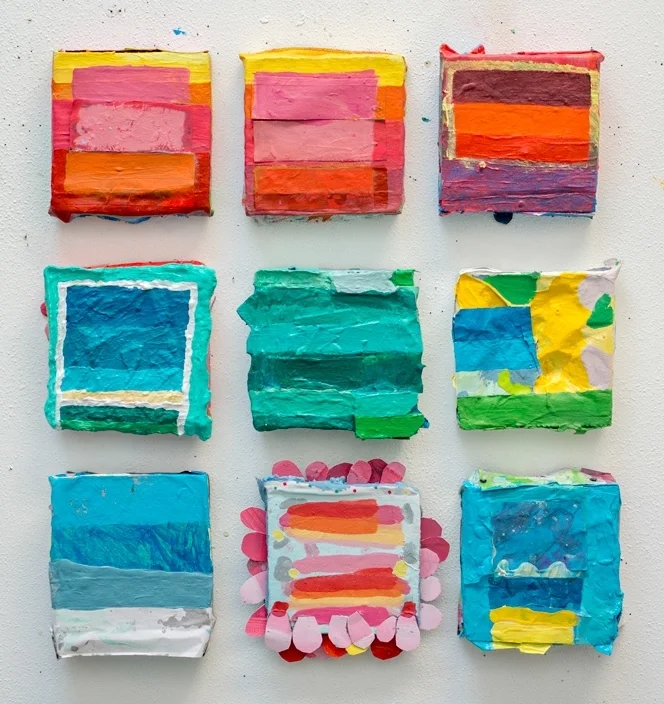Studio Visit | Noé Jimenez
Studio Visit | Noé Jimenez
Around age 12, New Haven-based artist Noé Jimenez built an elaborate treehouse in the New Milford suburbs with his friends. With scraps of wood and nails they stole from a nearby construction site, their fort had several stories with a wide platform base that spanned a brook. The boys built it in secret; no one knew of the treehouse until it had been completed one week later.
For three months, Jimenez and his friends returned to this space often. There, Jimenez remembers getting beaten up and starting fights of his own. Another friend had a bad asthma attack in the treehouse, too. When the construction crew later learned of this development, the treehouse was torn down. (They also started keeping their supplies under lock and key.) But the treehouse showed how creating something brings people together. “It seemed to illustrate that being creative can connect you to other people in a really literal way,” explained Jimenez.
Noé Jimenez, Gum, Grass, Debris, Water (2012). Oil and Acrylic on Canvas.
When Jimenez talks about art, he speaks often about community—the relationships that art can build between people and their environments. Jimenez has always been surrounded by art and people who adore it. His mother and father are poets. His father, who now resides in the Dominican Republic where both parents were born, recently self-published a book of poetry titled Palabras Mi Menor with illustrations by Noé. When he was younger, his mother, a licensed therapist in New Haven, belonged to a tertulia. She brought him along to gatherings in New York City and around Connecticut to see art and hear poetry.
By high school, Jimenez knew he wanted to pursue art professionally. As a junior, he met a graduate student named Clayton Cotterell at an open studios event in Bridgeport. A friendship grew and Jimenez became the subject of Cotterell’s thesis project at the School of Visual Arts in New York City. (The series explored the transition from adolescence to early manhood through photography.) Cotterell introduced Jimenez to the work of Jean-Michel Basquiat and Jimenez, who was sixteen at the time, was amazed at the frequency and depth of Cotterell’s conversations with his peers. A few years later he applied to art school.
After graduating from Paier College of Art in 2012, Jimenez began making paintings that were inspired by memories, especially the treehouse. In hindsight, Jimenez describes these paintings as hideous. He was interested in blending representational and abstract languages and the works were between painting and sculpture with thickly painted elements glued onto a flat surface. From there, Jimenez’s practice continued to evolve. He made installations and soft sculptures. Next, he began a series of petite works composed of painted papers pasted onto pieces of foam. These small, brightly colored compositions were freeform shapes, many with flower petals for edges. Displayed in groups, these arrangements were flexible and changeable, but the works felt incomplete to Jimenez. He explained, “It’s necessary for me to make things that are [conceptually] disposable before they are definitive.”
Noé Jimenez, Untitled Grid (2018). Paper and Acrylic on Foam.
Lately, more definition has emerged from Jimenez’s works. The paintings are flat and have been scaled up. The content has also become more narrative. When I visited his studio a few weeks ago, one large, mostly blue painting on paper showed two people sitting closely in the bottom right corner of the composition. Above them, puffy, pink flowers bloomed before a pond. The space of the painting is jumbled like a cartoon of all the feelings and ideas associated with the subject. Jimenez plans to add a canoe and a net to the painting, the theme for which is romance—the cheesy, yet authentic kind.
“Painting, in general, is funny and silly,” said Jimenez. “I take [it] very seriously because I love it, but it’s also silly.” Like his previous series of small works, his new body of paintings on paper feels immediate and accessible. Intuitively constructed, these paintings belong in groups but their order can be altered. Within the compositions, Jimenez layers pictures within pictures with references to screens, grids, and nets. Many of the flora in the paintings originate from the Dominican Republic, where Jimenez has traveled many times to see family and for the past three visits, caught parasites. The imagery represents “all the tragic and meaningful things in my life,” he said. For Jimenez, painting is a vehicle to make light of the more humdrum and humbling pieces of life: the hope of a budding relationship, the annoyance of a severe cat allergy, the discomfort of an intestinal parasite, the ways screens absorb and distract us. Nothing is left out of these paintings.
Noé Jimenez in his studio, November 2018.
Toward the end of our conversation, Travis Carbonella, another Westville artist, barged into Jimenez’s studio. Prompted for the reason behind the interruption, Carbonella replied he wanted a hug. Jimenez, like his paintings, is approachable and generous.
Noé Jimenez works in the West River Arts Studios in Westville, CT. He graduated with a BFA in Painting from Paier College of Art in 2012. Additionally, Jimenez studied painting at Colegio de España, Salamanca, Spain, University of Urbino, Italy, and Altos De Chavon, Dominican Republic. In 2014 he was a resident at Norðanbál on Hrisey Island in Iceland.
Jimenez’s untitled painting is on view at Real Art Ways as part of the Real Wall series through December 9.
To see more of his work, follow Jimenez on Instagram @BoboSkribs






